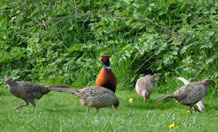
Experts found that individuals adjusted their own vigilance levels depending on the harem sizes they were placed in. Image credit: Peter Thompson/GWCT
In pheasant harems, bigger is not always better
Too many females in a wild pheasant harem harms the ability of the group to spot predators, experts from the University of Exeter have found.
Males and females adjust their vigilance levels with harem size, collectively this has consequences for the ability of the group to detect a predator, a new study shows.
Scientists from the University of Exeter and the Game & Wildlife Trust (GWCT) observed 81 male and 43 female pheasants living wild on an estate in the UK, just before the breeding season began. They watched individuals foraging and being vigilant, whilst in harems of varying size in the wild.
There are three key ingredients to pheasant reproductive success: food, sex and predation avoidance. Pheasants work in groups so they can take turns to look for predators, and then they are able to eat and procreate so we may expect males to want as many females in a harem as possible.
Females in larger harems were less vigilant than females in smaller harems. Males showed the opposite trend, with vigilance increasing for males with larger harem sizes.
Modelling the likelihood that a group would detect a predator based on observed vigilance showed that optimal detection occurred with a harem of 2.7 females. This figure closely matched the average harem size on the estate.
The experts looked further to see if individuals adjust their own behaviour when experimentally placed into harems of differing size in captivity. At first ten males were assigned to a harem either of two or four females. After seven days of one harem size, males were assigned to the other harem size.
They found that individuals adjusted their own vigilance levels depending on the harem sizes they were placed in. With larger harem sizes females would spend more time foraging and less time vigilant. But the reverse was true for males.
Such behaviour could explain why we see relatively small harem sizes in wild pheasants. Females benefit from being in a large harem as reduction in individual vigilance allows for them to increase time spent foraging, a feature necessary when preparing for a breeding season. Males try to shoulder the burden of standing guard by adjusting their own vigilance levels but with too many females they simply cannot compensate and as a result the safety of the group is compromised due to the lack of collective vigilance.
Dr Mark Whiteside, who led the study, said: “Pheasant harems provide a unique system that make us think again about the relative costs and benefits to individuals when in a group.
With males and females differentially adjusting their behaviour with harem size, we may find that sexual attractiveness is not the only factor influencing harem size in pheasants, and perhaps it has a lot more to do with the ability of the male to sustain the cost of watching out for predators or rivals."
Males and females differentially adjust vigilance levels as group size increases: effect on optimal group size features in the journal Animal Behaviour.
Date: 24 June 2016
